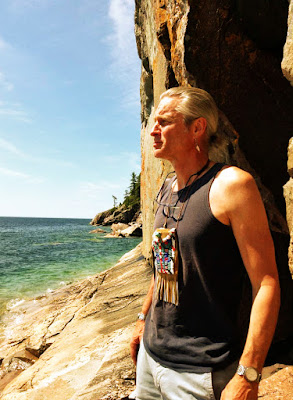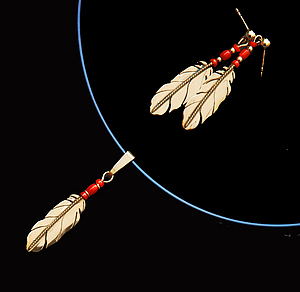 |
"Sky Healer" © 2022 Zhaawano Giizhik |
___________________________________________
Entering a Different Reality
Boozhoo, aaniin, hello,
This blog story is the 25th already in a series titled "Teaching Stories."
The series features my - non-commercial- jewelry and works of art, occasionally along with images of paintings by kindred artists. The stories thematically connect the jewelry and artwork displayed with the Seven Grandfather teachings of the Ojibwe Anishinaabe People.
__________________________________________________________
The question we will ask ourselves today is: What is it that defines us as Native Woodland artists? What makes us spiritual artists? And how do we deal with the sacred?
Me and my fellow artists, what unites us is that we work in the discipline of the Canada-based NATIVE WOODLAND ART. Most of us are painters with an Anishinaabe or Ininew (Cree) background. Some of us call ourselves MEDICINE PAINTERS, rather than Woodland artists. Woodland artists is a name that outsiders address us with.
Finding the core of the ancient art forms of our Peoples by drawing on their pictorial and oral traditions that spring from pre-dawn time lies at the base of our art. (Re)telling engaging teaching stories through our canvases and designs and drawings - and in my case, sometimes jewelry - is always our common goal. In the process of telling stories trough our paintings or jewelry-making or graphic and digital design, we find much joy and inspiration and, above all, HEALING and MEDICINE in tracing back the footsteps of our ancestors.
So, as a Woodland artist I basically consider myself a MODERN STORYTELLER. What I do, trough the guidance of the sacred records and teachings of long ago, is (re)create the ancient symbols and visual language of the mazinaajimowinan, or pictographs; respectfully I render these traditional elements into my graphic art and contemporary designs of precious metals and stone.
There is always a healing aspect to the creative process involving our art-making. So, in a way, we are storytellers AND healers; trough our creations we tell HEALING STORIES. We heal ourselves and we heal those who listen to our stories.
This requires continuous learning from and studying – and sometimes even dreaming about – the ancestral teachings. Sometimes, in doing this, we enter a different world where we ‘see’ and ‘hear’ things we would never experience in this reality.
As we are limited in what we know - or can reveal - about the ancient ceremonies and teachings, the challenge for us lies in creating abstract designs that work on a mysterious level and approach, or (respectfully) represent, the sacred.
__________________________________________________________
__________________________________________________________
__________________________________________________________
INSPIRATION IS AN EAGLE FEATHER
There is, of course, no creative process without inspiration. But what is inspiration and how does it work? Lets start with the Ojibwe word for inspiration, aanzinaamowin. It literally means, "breath change." Aanzinaamowin can mean both inspiration and expiration. So it isn't hard to imagine inspiration is directly concerned with our breath, or the breathing of something - be it a thought, an emotion, a story, or the breath of gichi-manidoo (anything spiritual) into and out of us, the artists. It is like Debaajimood, our first Storyteller explained to Nookomis (Grandmother) when she asked him where his stories come from and what it is that makes a story alive:
"Like a tree or like you and me or a plant
or a fish or a bird, a story inhales, and when it is listened to it exhales;
when it is passed on its blood flows, just like the sap of a tree in spring, or
like my blood flows when I tell a story to you and your blood flows when you
listen to me telling the story.”
This, of course, makes one wonder where the English word "inspiration" comes from. Could it be its etymology resembles that of its Ojibwe counterpart, aanzinaamowin?
__________________________________________________________
__________________________________________________________________________
 |
| Debaajimod's Gift © 2023 Zhaawano Giizhik |
__________________________________________________________
_____________________________________________________________________________
The word inspiration traces back to the Latin inspirare (“to breathe or blow into”), which itself is from the word spirare, meaning “to breathe.” Many people did not just take it in a mere literal sense; the earliest written English uses of inspire give it the meaning “to influence, move, or guide (as to speech or action) through divine or supernatural agency or power.”* It is not surprising to learn that early figurative senses of inspire are often religious in nature; which in itself is quite logical since the word shares a connection with spirit (which comes from the Latin word for “breath,” spiritus, which is also from spirare).
Like the Ojibwe aanzinaamowin, a number of other early European senses of "inspire" were indeed concerned with breath and blowing; beginning in the late 14th century the word carried such meanings as “to breathe or blow upon,” “to breathe in,” and “to infuse (as life) by breathing.
What then, is the ideal state of mind to acquire inspiration? Personally, I believe that the factor time is unimportant when it comes to design inspiration, or receiving a vision - the design, or vision, will appear sooner or later. Do not think of it as a burden, but as something that is weightless, like an eagle feather whirling down from the sky - or like the breath you exhale when you rise to greet the cold morning sky - or like the sudden unexpected appearance of diamond dust in a winter sky.
More often than not, the inspiration/vision is when you least expect it to happen, because there's usually something else, another interest or goal - sometimes as passionate or intensively felt - that will lead you to it. It falls out of the sky and lands in front of you when you least expect it. I call it eagle feather serendipity.
Nahaaw, miigwech gibizindaw noongom. Thank you for listening to me today. Giga-waabamin wayiiba giishpin manidoo inendang, I will see you again soon, if the Great Mystery wills it. Mino bimaadizin! Live well!
__________________________________________________________
Illustration:
Giizhig Nenaandawi'iwed ("Sky Healer"), from the series "Dance of Life." © 2022 Zhaawano Giizhik.
Jewelry image:
Giizhigo-aadisookaanag ("Sky Spirits"), set of 14K gold eagle feathers adorned with red coral. The set serves as a storytelling tool and is not for sale.
__________________________________________________________
About the author and his sources of inspiration:

My name is
Zhaawano Giizhik. My clan is waabizheshi, the marten.
As
an American non-commercial artist and jewelry designer currently
living in the Netherlands, I like to draw on the oral and pictorial traditions of my Ojibwe
Anishinaabe ancestors from the American Great Lakes area. For this I call on
my manidoo-minjimandamowin, or "Spirit Memory"; which means I
try to remember the knowledge and the lessons of my ancestors.
The
mazinaajimowinan or ‘‘pictorial spirit writings’’ - which are rich with
symbolism and have been painted throughout history on rocks and etched on other
sacred items such as copper and slate, birch bark and animal hide - were a form
of spiritual as well as educational communication that gave structure and
meaning to the cosmos.
Many
of these sacred pictographs or petroforms – some of which are many, many
generations old - hide in sacred locations where the manidoog (spirits)
reside, particularly in those mystic places near the coastline where the sky,
the earth, the water, the underground and the underwater meet. It is these
age-old expressions that provide an endless supply of story elements to my
work; be it graphically, through my written stories, as well as in the
context of my jewelry making.
________________________________________________________




No comments:
Post a Comment